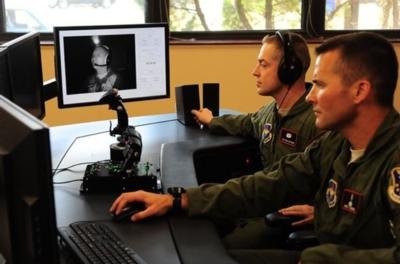New Simulator Focuses On Spatial Disorientation
Spatial disorientation, the inability to determine one’s position in an open space, can lead to a dangerous scenario inside a cockpit.

The disorientation is caused when the body's internal gyros do not match up with aircraft instrument readings and what the pilot expects to see. It occurs because current trainer technology is not of a high enough quality. However, that’s changing with the implementation of a new simulator, the GYRO Integrated Physiological Trainer II, into Specialized Undergraduate Pilot Training. Columbus Air Force Base joins Sheppard AFB, Texas, in operating the new technology.
The simulator will allow SUPT students to begin spatial disorientation training before they even enter the aircraft.
"What this will do is let the students get realistic, hands-on experience in an environment much like the one in the T-6(A Texan II)," said Maj. Michael Fleming, the 14th Medical Group Aerospace Physiology Flight commander. "Our new simulator lets them be in the same sitting position and the same posture they would be in while flying and still experience that same spatial disorientation they would experience while flying."
The simulator exposes users to typical vestibular (inner ear) and visual illusions found in aviation, teaching them to recognize, confirm, prevent and recover from spatial disorientation before they fly for the first time.
The former spatial disorientation simulator device was the Barany chair. By maintaining certain body and posture positions while spinning on the chair, it could give a sense of the effects, but not in a cockpit.
"We are literally replacing 100-year-old technology here," said Capt. Sharon Elliott, the 14th MDG officer in charge of physiology operations. "Before we could use the Barany chair to manipulate (spatial disorientation), but now they will get to experience it in the most realistic environment possible."
Fleming explained how the GYRO IPT II is able to simulate various sensations of roll, pitch, yaw, and the sense of acceleration and tilt felt during takeoff.
In addition to feeling the effects, GYRO IPT II users actually fly the simulator in a fully interactive flight training environment, similar to that of the T-6A, and experience flying under those effects without the repercussions of crashing an actual aircraft.
"(Spatial disorientation) causes mishaps in the Air Force and so we have been looking for a solution to this problem for years," Fleming said. "This device will save lives in the long run because it will prepare them for experiencing (spatial disorientation) inside the aircraft, allowing them to respond and react to it faster."
By January 2016, Sheppard AFB; Vance AFB, Oklahoma; Columbus AFB; Laughlin AFB, Texas; and Joint Base San Antonio-Randolph, Texas, will all have the simulators in their facilities and as part of the syllabus for student and instructor pilot training.
(USAF image. Tech. Sgt. Benjamin Hoffman and Maj. Michael Fleming monitor Col. James Fisher on the video feed from the cockpit of the new spatial disorientation simulator Aug. 5, 2015, at Columbus Air Force Base, Miss. Hoffman and Fleming directed Fisher through various sensations of roll, pitch and yaw to induce spatial disorientation)
 Classic Aero-TV: In Praise of Alabamas Patriot Aircraft USA
Classic Aero-TV: In Praise of Alabamas Patriot Aircraft USA NTSB Final Report: Cirrus Design Corp SR22
NTSB Final Report: Cirrus Design Corp SR22 ANN's Daily Aero-Term (12.21.25): Dead Reckoning
ANN's Daily Aero-Term (12.21.25): Dead Reckoning ANN's Daily Aero-Linx (12.21.25)
ANN's Daily Aero-Linx (12.21.25) Aero-News: Quote of the Day (12.21.25)
Aero-News: Quote of the Day (12.21.25)



